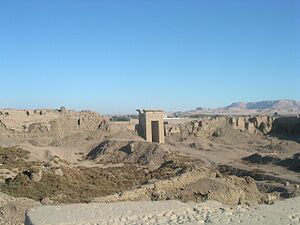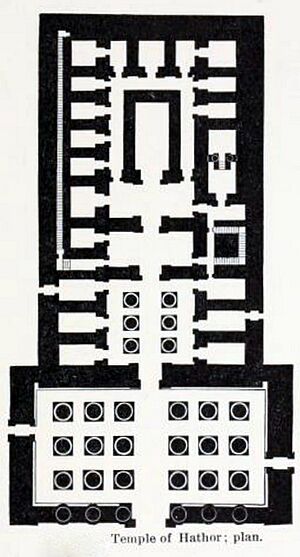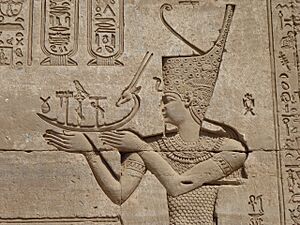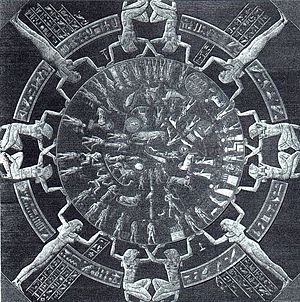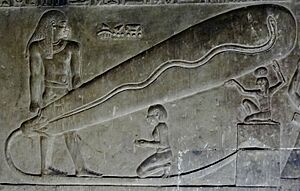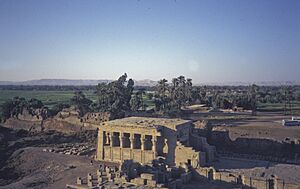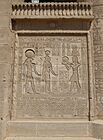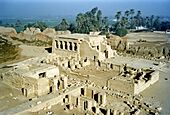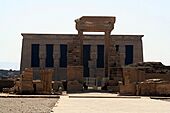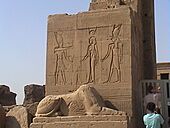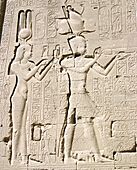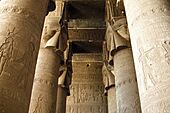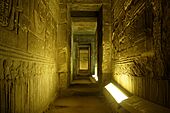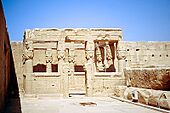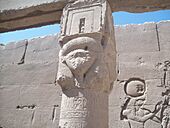Dendera Temple complex facts for kids
The Dendera Temple complex is an amazing ancient Egyptian temple site. It is found about 2.5 miles (4 km) south-east of Dendera, Egypt. This complex is one of the best-preserved temple sites from ancient Egypt. Long ago, this area was an important region in Upper Egypt.
Contents
What is the Dendera Temple Complex?
The entire complex is surrounded by a very large mudbrick wall. Dendera was once a busy oasis town near the Nile River. Thousands of people lived there in its busiest times.
Because the complex is so big, its buildings were constructed over many different periods. This includes the Middle Kingdom, the Ptolemaic Era, and when the Romans ruled Egypt. There is even proof that an older building stood here around 2250 BC. The oldest building still standing today was built by Nectanebo II. He was the last native pharaoh of Egypt (360–343 BC).
The complex has many interesting features, including:
- The Hathor temple (this is the main temple)
- The Temple of the birth of Isis
- A Sacred Lake, used for rituals and daily life
- A Sanatorium, like an ancient healing center
- People would bathe here and stay overnight. They hoped to have healing dreams. The water was thought to be sacred.
- The Mammisi of Nectanebo II
- A Basilica
- The Roman Mammisi
- A Barque shrine
- This was a special resting place for statues of the gods. They used it when the statues were carried outside during festivals.
- Gateways built by Domitian and Trajan
- The Roman Kiosk
It is important not to confuse the Dendera Temple with the Dendera Necropolis. A necropolis is a large cemetery. The Dendera Necropolis has many tombs. These tombs are much older than the Temple of Hathor.
Exploring the Hathor Temple
The most important building in the complex is the Temple of Hathor. It really stands out to visitors. This temple was changed and added to many times over hundreds of years. The temple we see today started being built around 54 BC. This was during the late Ptolemaic period. The large main hall, called the hypostyle hall, was built later by the Romans.
The Roman Emperor Trajan helped build and decorate many buildings in Egypt. You can see him and Domitian in scenes on the temple's entrance. These scenes show them making offerings to the gods.
The Hathor Temple has many different rooms and areas:
- A Large Hypostyle Hall (a hall with many columns)
- A Small Hypostyle Hall
- A Laboratory
- Storage rooms
- An Offering entry
- A Treasury
- An Exit to a well
- Access to a stairwell
- An Offering hall
- The Hall of the Ennead (a group of nine gods)
- The Great Seat and main sanctuary
- Shrines for different gods, like Isis and Sokar
- The Pure Place
- A Court for the First Feast
- Passages and staircases to the roof
You can see pictures of Cleopatra VI on the temple walls. These are great examples of art from the Ptolemaic period. On the back of the temple, there is a carving of the famous Cleopatra VII and her son, Caesarion. Caesarion's father was Julius Caesar.
The Hathor Temple also shows ten dead gods. These are linked to nine dead gods at Horus's temple in Edfu. This is because Hathor and Horus were often seen as a couple or mother and son.
What is the Dendera Zodiac?
The Dendera zodiac is a famous carving found in the temple. It shows the zodiac signs we still use today, like Taurus (the bull) and Libra (the scales). A drawing of it was made during Napoleon's time in Egypt.
In 1820, this carving was removed from the temple ceiling. It was taken by French colonizers and replaced with a copy. There is still debate about whether they had permission to take it. The real zodiac is now in the Louvre Museum in France. Jean-François Champollion, who famously deciphered the Rosetta Stone, said it was from the Ptolemaic period. Later, experts confirmed he was right. They now believe it dates back to the first century BC.
What are the Crypts?
The Hathor temple has twelve secret underground rooms called crypts. Some carvings in these crypts are from the time of Ptolemy XII Auletes. These crypts were likely used to store special containers and sacred items for the gods.
One crypt has a relief showing Pepi I offering a small statue of the god Ihy to four images of Hathor. Hathor is believed to be Ihy's mother. Another crypt shows Ptolemy XII with jewelry and offerings for the gods.
What is the Dendera Light?
Some stone carvings in the Hathor Temple show Harsomtus as a snake coming out of a lotus flower. Harsomtus is also known as Horus. He is seen as a very old "creator god." He is probably shown here because the main temple is for Hathor, and Harsomtus is often called her son or lover.
In six of these carvings, Harsomtus is inside an oval shape. This shape might represent the womb of the goddess Nut. These carvings look a bit like ancient lamps or lights.
How is the Temple Being Restored?
Restoration work on the temple began in 2005. It stopped for a few years and then started again in 2017. Experts are carefully cleaning and repairing the temple. As of March 2021, the second part of the restoration was finished. This included cleaning the Great Pillars Hall. They also brought back the original bright colors of the paintings on the walls and ceilings. Work is still ongoing. There is also a project to turn the temple courtyard into an open-air museum.
The Roman Mammisi
The Roman mammisi is a smaller building next to the main temple. It was built during the time of Emperors Trajan and Marcus Aurelius. You can see many carvings of Trajan making offerings to Egyptian gods.
The presence of the Roman mammisi shows how long and complex the history of Romans in Egypt was. The carvings even show Emperor Trajan dressed as an Egyptian Pharaoh. He is seen giving gifts to the Egyptian gods.
-
Roman Emperor Trajan at Dendera, Egypt
-
Roman Emperor Trajan brings offerings to Hathor and Ra-Harakhte, Dendera.
Recent Discoveries
In March 2023, archaeologists found a limestone sphinx during their digs. This sphinx has a slight smile and dimples. It is believed to be a likeness of the Roman emperor Claudius. On the sphinx's head is a special headpiece called a nemes. It has a cobra-shaped tip called a uraeus.
Visiting the Dendera Temple
The Dendera complex has always been a popular place for tourists. It used to be possible to visit almost every part of the complex. You could go from the crypts all the way to the roof. However, the highest part of the Hathor temple roof has been closed since 2003. The second part of the roof was closed in November 2004.
Gallery
-
Entrance gate to the temple, with bas-relief and sphinx
-
Reliefs of Cleopatra VII and her son by Julius Caesar, Caesarion at the Dendera Temple
See also
- Esna temple
- List of Ancient Egyptian sites



